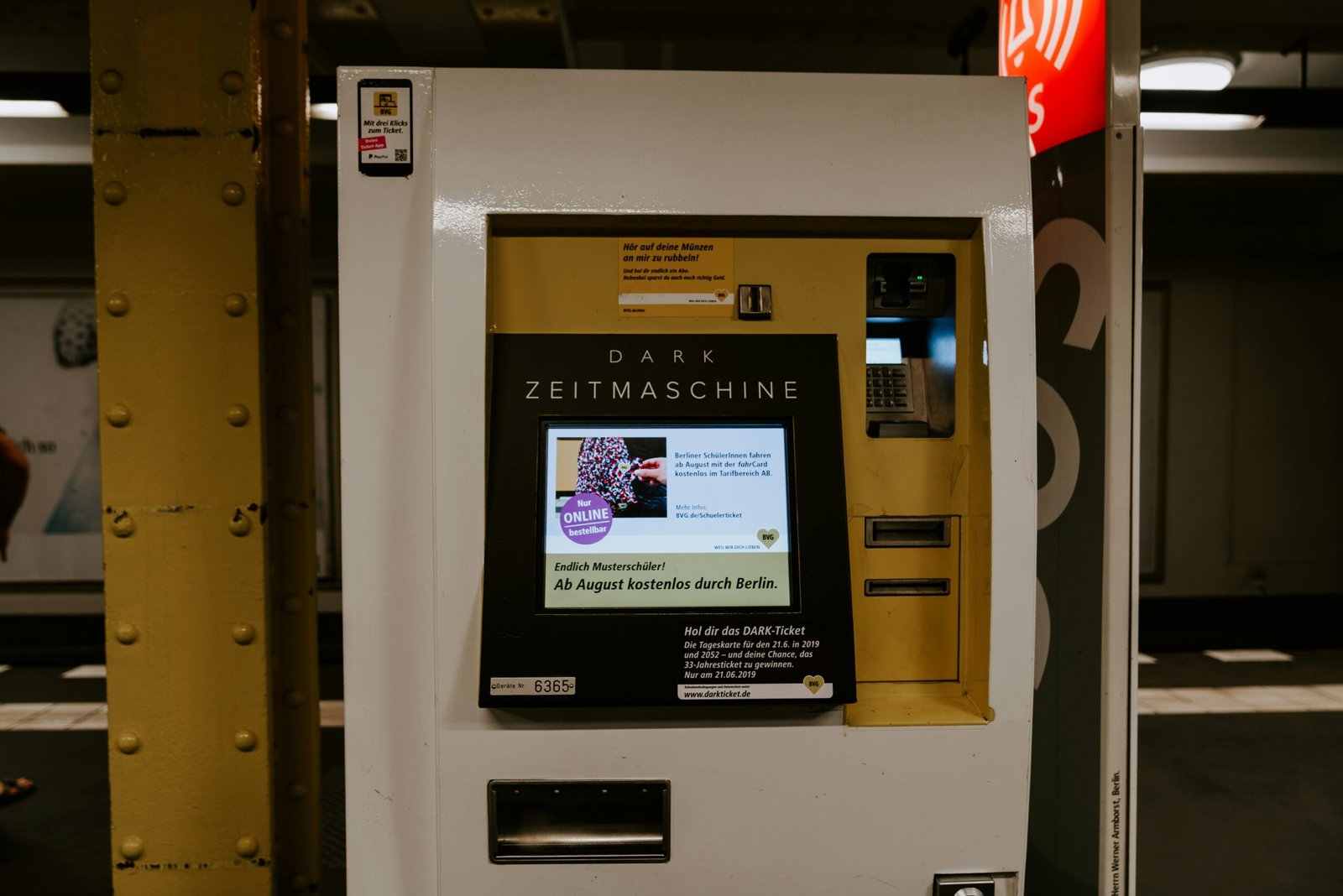In today’s digital age, the integration of technology within retail environments has become increasingly vital.Networking kiosks in a mall setting is a prime example of how technology can be leveraged to enhance customer experiences, streamline operations, and provide valuable data for mall management.
The interconnectedness of these kiosks facilitates a cohesive and seamless shopping experience, transforming the traditional mall into a more engaging and efficient space.One of the key advantages of interconnected kiosks is the enhancement of the customer experience.
Networked kiosks can offer a variety of services, such as wayfinding, information about store promotions, and even interactive directories.These services not only make it easier for customers to navigate the mall but also engage them with personalized content and offers.
This level of interaction can significantly improve customer satisfaction and encourage repeat visits.From an operational perspective, networked kiosks streamline various processes. For example, they can be used for managing queue systems, providing real-time updates on wait times, or even enabling self-service checkouts.
This reduces the burden on human staff, allowing them to focus on more complex tasks that require a personal touch.Additionally, networked kiosks can be updated remotely, ensuring that information is always current without the need for manual intervention.
Furthermore, interconnected kiosks provide mall management with a wealth of data that can be used for strategic planning and decision-making.By analyzing data collected from kiosk interactions, management can gain insights into customer behavior, preferences, and peak shopping times.
This information is invaluable for optimizing store layouts, tailoring marketing campaigns, and improving overall mall operations.In conclusion, the networking of kiosks within a mall setting offers numerous benefits.It enhances the customer experience, streamlines operations, and provides valuable data for informed decision-making. As such, it represents a crucial step in the evolution of modern retail environments.
Assessing Network Requirements
Effective planning is crucial for establishing a robust network that connects all kiosks in a mall. The first step in this process is conducting a thorough site survey.This survey is essential to understand the mall’s layout, which directly impacts the network design. The physical layout of the mall, including the distance between kiosks, plays a significant role in determining the type and quantity of networking hardware required.
The survey should document the size and shape of the mall, the number and locations of kiosks, and any potential obstacles that could interfere with network signals.Understanding the specific requirements of each kiosk is another critical element. Kiosks may have varying needs depending on their function.
For instance, some kiosks might require higher bandwidth to support video streaming or interactive displays, while others may only need minimal bandwidth for simple transactions or information dissemination.Assessing these needs will help in selecting the appropriate network equipment and ensuring that each kiosk receives adequate bandwidth.
Security considerations are paramount when connecting multiple kiosks within a mall. Sensitive data, such as customer information and payment details, must be protected against unauthorized access.The site survey should include an evaluation of potential security risks and vulnerabilities. Implementing secure network protocols, such as WPA3 for wireless connections and VPNs for data transmission, can mitigate these risks.
Additionally, regular security audits should be part of the network maintenance plan to ensure ongoing protection against emerging threats.In summary, assessing network requirements for connecting kiosks in a mall involves a detailed site survey to understand the mall’s layout, evaluating the specific bandwidth needs of each kiosk, and addressing security considerations.
These steps are foundational to designing a network that is both efficient and secure, ensuring seamless operation of all kiosks within the mall.
Choosing the Right Networking Equipment
When setting up a network for all kiosks in a mall, selecting the appropriate networking equipment is paramount. The foundational elements include routers, switches, and cabling. Each component plays a critical role in ensuring seamless connectivity and optimal performance. To make an informed decision, it’s essential to consider both the network requirements and budget constraints.
Routers are the backbone of any network, directing data traffic efficiently. When choosing a router, consider the number of devices that will connect to the network. For a mall environment, a high-capacity router capable of handling multiple connections simultaneously is ideal. Look for features such as dual-band frequency to reduce interference and ensure a stable connection for all kiosks.
Switches are equally important as they expand the network by connecting multiple devices. Managed switches offer greater control and flexibility, allowing network administrators to prioritize traffic and ensure optimal performance.
On the other hand, unmanaged switches are cost-effective and simpler to deploy but provide less control. The choice between managed and unmanaged switches depends on the specific needs and technical expertise of the network administrators.Cabling is another crucial component.For most mall environments, Ethernet cabling, specifically Cat6 or Cat6a, is recommended due to its high-speed capabilities and reliability.
When selecting cabling, consider the layout of the mall and the distance between kiosks. Fiber optic cables might be necessary for longer distances, offering faster speeds and reduced latency compared to traditional copper cabling.Budget constraints also play a significant role in the decision-making process.
While high-end equipment offers superior performance and features, it’s essential to balance cost and functionality. Investing in quality networking equipment can lead to long-term savings by reducing maintenance costs and minimizing downtime.
In conclusion, selecting the right networking equipment involves a careful assessment of the network’s demands and budgetary limitations. Prioritizing routers, switches, and cabling that meet these criteria will ensure a robust and efficient network for all kiosks in the mall.
Setting Up a Wired Network
Setting up a wired network for kiosks in a mall involves a series of methodical steps, ensuring not only the physical connection but also the proper configuration and testing to guarantee seamless communication.The first step in this process is laying down the physical cables. Typically, Cat5e or Cat6 Ethernet cables are used due to their capacity to handle high data transfer rates and reliability.
These cables should be routed through conduits or cable trays to protect them from physical damage and to maintain an organized layout. Proper labeling of each cable is crucial for future maintenance and troubleshooting.
Subsequent to laying the cables, the next phase is connecting them to network switches and routers. Network switches serve as the central node in a wired network, allowing multiple devices to communicate efficiently.
It is essential to use switches with sufficient port capacity to accommodate all the kiosks. Routers, on the other hand, manage the data traffic between the local network and external networks, such as the internet. In a mall setting, a high-performance router is recommended to handle the potentially large volume of data traffic.
Once the physical connections are established, the network devices need to be configured. This includes assigning static IP addresses to each kiosk to ensure consistent communication and reducing the likelihood of IP conflicts.Network security protocols, such as setting up a firewall and enabling encryption, are also vital to protect sensitive data transmitted across the kiosks.
The final step is rigorous testing of the network. Each connection should be tested to verify that data can be sent and received without interference.Tools like network analyzers can help identify any potential issues, such as latency or packet loss, which should be addressed promptly.
Proper documentation of the network setup, including IP addresses, cable routes, and device configurations, is essential for future maintenance and troubleshooting.
Implementing a Wireless Network
Setting up a wireless network in a mall environment requires careful planning and execution to ensure comprehensive coverage and robust security.
The first step involves strategically placing access points (APs) throughout the facility. Proper placement is critical to avoid dead zones and to provide seamless connectivity for all kiosks.Begin by conducting a site survey to identify high-traffic areas and potential sources of interference, such as electronic devices or structural obstacles. This survey will inform the optimal locations for your APs and help ensure uniform signal strength across the mall.
Once the placement of access points is determined, the next step is configuring them for optimal coverage. This includes adjusting the power levels of each AP to balance the network load and prevent overlap, which can cause interference.
It’s also essential to set the appropriate channels on each AP to minimize cross-channel interference. Utilizing dual-band APs can significantly enhance network performance by distributing the load between the 2.4 GHz and 5 GHz frequency bands. Security is a paramount concern when implementing a wireless network in a public space like a mall. To protect the network, ensure that each AP is secured with robust encryption protocols such as WPA3.
Additionally, employ strong passwords and regularly update them to prevent unauthorized access. Implementing a separate guest network with limited access can also enhance security by isolating public traffic from sensitive internal network operations.
Furthermore, enabling network monitoring tools can help in maintaining the health and security of the wireless network. These tools can detect anomalies, unauthorized access attempts, and performance issues, allowing for timely interventions. Regularly updating firmware and software is also crucial to protect the network from vulnerabilities and to ensure compliance with the latest security standards.
By carefully planning access point placement, configuring them for optimal performance, and implementing stringent security measures, a reliable and secure wireless network can be established to support all kiosks in a mall environment.
Network Security Considerations
When connecting computers in a mall for all kiosks, network security is paramount. Ensuring the protection of sensitive data and customer privacy requires a multi-layered approach.
One of the primary defenses is the implementation of firewalls. Firewalls act as a barrier between the internal network and external threats, filtering incoming and outgoing traffic based on predetermined security rules.This first line of defense is crucial for blocking unauthorized access and preventing potential cyber attacks.
Another essential component of a robust network security strategy is the use of Virtual Private Networks (VPNs). VPNs encrypt the data transmitted between kiosks and the central server, rendering it unreadable to any potential interceptors. By creating a secure tunnel for data transmission, VPNs ensure that sensitive information such as payment details and customer personal data remain confidential. This encryption is vital for maintaining trust and compliance with data protection regulations.
In addition to firewalls and VPNs, encryption methods play a critical role in safeguarding data. Encryption transforms readable data into an encoded format that can only be deciphered with the correct decryption key. Implementing strong encryption protocols, such as Advanced Encryption Standard (AES), ensures that even if data is intercepted, it remains unintelligible to unauthorized parties.
This is particularly important for protecting transactional data and personal information from cyber threats. Regular security audits and updates are also necessary to maintain the integrity of the network. These audits help identify potential vulnerabilities and ensure that the latest security patches are applied.
By continuously monitoring and updating the network, administrators can stay ahead of emerging threats and ensure that the kiosks’ data remains secure. In conclusion, network security considerations for connecting computers in a mall involve a multi-faceted approach. Through the implementation of firewalls, VPNs, and robust encryption methods. Along with regular security audits, businesses can safeguard kiosks’ data and ensure customer privacy, ultimately fostering a secure and trustworthy environment.
Monitoring and Maintenance
Effective monitoring and maintenance are critical components to ensure the seamless operation of computer networks in a mall, especially for all kiosks. Regular network monitoring helps in promptly identifying potential issues and mitigating them before they escalate into significant problems. This proactive approach not only enhances the network’s reliability but also improves the overall user experience for both customers and staff. One of the primary tools for network monitoring is a Network Management System (NMS). An NMS provides real-time insights into the network’s performance, including bandwidth usage, latency, and error rates. By continuously analyzing these metrics, network administrators can detect anomalies that may indicate underlying issues.
For instance, sudden spikes in network traffic could signal a potential security threat, while increased latency might point to hardware or configuration problems. In addition to real-time monitoring, regular maintenance tasks are essential to keep the network in optimal condition. This includes routine software updates for network devices such as routers, switches, and firewalls.
These updates often contain critical security patches and performance improvements that can prevent vulnerabilities and enhance the network’s efficiency. Firmware updates should also be scheduled periodically to ensure that all hardware components are running the latest versions.
Another key aspect of network maintenance is the regular review and optimization of network configurations. As the mall evolves and new kiosks are added, the network topology may need adjustments to accommodate increased traffic and ensure balanced load distribution.
Conducting periodic network audits can help identify outdated configurations and optimize the network for current demands. Furthermore, implementing a robust backup and recovery strategy is vital for minimizing downtime in case of network failures.
Regularly backing up network configurations and critical data ensures that the network can be quickly restored to its operational state after an incident, reducing the impact on mall operations. Overall, a comprehensive approach to monitoring and maintenance involving the use of advanced tools and regular upkeep tasks is essential for maintaining a reliable and efficient network for all kiosks in a mall. This ensures uninterrupted service and a positive experience for all users.
Future-Proofing the Network
Future-proofing the network within a mall environment, especially for all kiosks, requires a strategic approach that emphasizes scalability, the adoption of new technologies, and meticulous planning for future upgrades. As malls continue to evolve and integrate more digital solutions, creating a robust and adaptable network infrastructure becomes imperative.
Scalability is a cornerstone of future-proofing. To ensure that the network can handle increasing data traffic and the addition of new devices, it is essential to implement scalable network solutions. This means choosing hardware and software that can be easily expanded or upgraded. For example, investing in modular switches and routers allows for additional capacity without the need for a complete overhaul of the existing infrastructure.Adopting new technologies is another critical element.
The rapid pace of technological advancements necessitates a network that can seamlessly integrate emerging technologies. This includes upgrading to higher bandwidth capabilities, such as moving from traditional Ethernet to fiber optics, which can support faster data transfer rates and higher volumes of data.
Additionally, adopting wireless technologies like Wi-Fi 6 can significantly enhance the network’s performance and reliability, providing a better experience for both kiosk operators and users.Planning for future upgrades is equally important. This involves not only keeping abreast of the latest technological trends but also proactively planning for regular upgrades.
Establishing a clear timeline for network assessments and updates ensures that the infrastructure remains current and capable of meeting future demands. Additionally, employing network monitoring tools can help identify potential issues before they become critical, allowing for timely interventions.
In conclusion, future-proofing the network for all kiosks in a mall involves a multifaceted approach that prioritizes scalability, embraces new technologies, and plans for ongoing upgrades. By taking these steps, mall operators can ensure a resilient, efficient, and adaptable network that supports current needs while being prepared for future growth and innovations.



